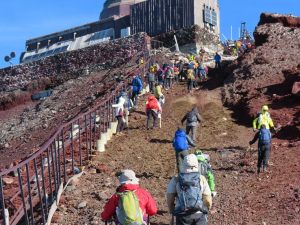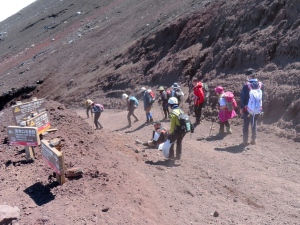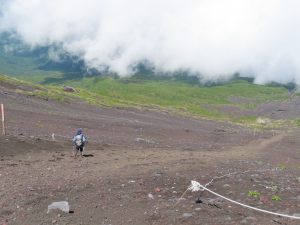Accidents
Why do rockfalls occur?
Mt. Fuji is made up of multiple piles of volcanic gravel that easily collapses (*)
In addition to it:
1. Natural occurrences due to typhoons, heavy rain, etc.
2. Land and stone collapse caused by people walking nearby
*The trails of Mt. Fuji are trampled by many people and crawler vehicles even above the tree line, so the gravel is stable and does not collapse that much. However, outside the trail, footing is extremely unstable and you may slip down. Furthermore, with each step you make, rocks fall. Though small at first, if the falling rocks is not stopped quickly, it will accelerate. A chain reaction develops into a large rockfall. It is important that you understand the difference between on and off the trail.
Preventive measures against falling rocks and slipping
・Never leave the trail
・Never throw stones
Never leave the trail
Trails are separated by ropes and chains. People often take breaks outside the trails to allow others to pass. Also, during a sunrise traffic jam, others take shortcuts by climbing directly up the slope because they don't want miss the sunrise. Furthermore, on long zigzag descending roads such as on the Yoshida Route, some people recklessly run down the slope directly because they want to get down the mountain quickly. Both of these actions are extremely dangerous. Never do this, as it puts not only you but everyone around you at risk.
Do not rest on the edge of the valley side of the trail
The edge of the valley side of the trail is especially dangerous due to the risk of falling rocks hitting others walking below. It is best to take breaks in large areas such as at mountain huts. However, if you absolutely need to take a break on the trail, take a break on the mountain side of the trail, at a cutback where you will not be in the way.
Also, when you take a break, do not lie down because you may not be able to respond to falling rocks. If something happens, you should be ready to evade the situation immediately. Someone in your group should remain alert of the situation.
Never throw stones
Even if you cannot see anyone in front of you, falling rocks caused by thrown stones may hit climbers walking below. This is common sense on mountains, but especially if you are climbing with children, please be careful.
<Recommendation of Hememet>
On the Yoshida trail, rental helmets are available at the 6th station safety guidance center for a 2,000 yen deposit. On the Fujinomiya trail, free helmets are available (quantities limited). Please consider.
Injury
Please be especially careful in these places.
A hard ground steep slope covered with a thin layer of pebbles and gravel (scoria). (Example: "Uma-no-se" located just below Kengamine at the summit of Mt. Fuji, the steep slope from near Mt. Fuji Hotel to Shita-Edoya hut at the 8th station of Yoshida/ Subashiri descending trail)




<To prevent injury>
- We recommend high-cut shoes that go up to the ankles to protect your ankles. (Sneakers are not recommended as they can be slippery and won't protect your ankles.)
- When you fall, your hands are often injured because you instinctively try to protect your body. Wear gloves just in case. Also, avoid exposing your elbows and knees to prevent injuries.
- It's reassuring to have a walking stock so you don't lose your balance. (Especially when going downhill)
<To prevent shoe blisters>
- If the shoes don't fit the shape of your feet, you're likely to get blisters. If you climb Mt. Fuji with new shoes, we recommend breaking them in for a few days beforehand to let your feet adjust to them.
- If you know which parts of your feet are prone to shoe blisters, you can also tape them in advance.
- We recommend that your group pack a first aid kit in case you get injured or get a sore shoe.


